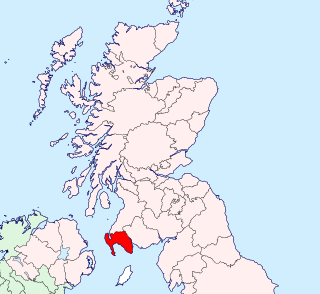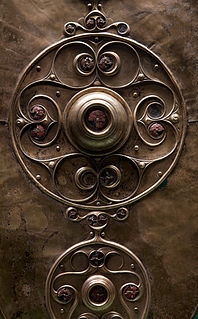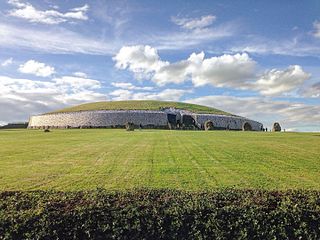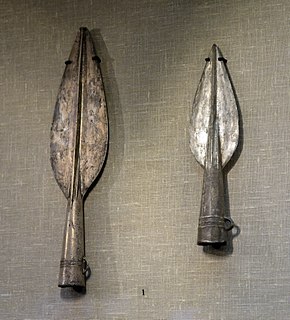
The Bronze Age is a historic period, lasting approximately from 3300 BC to 1200 BC, characterized by the use of bronze, the presence of writing in some areas, and other early features of urban civilization. The Bronze Age is the second principal period of the three-age system proposed in 1836 by Christian Jürgensen Thomsen for classifying and studying ancient societies and history.
The Copper Age, also called the Chalcolithic or (A)eneolithic or Aeneolithic, is an archaeological period characterized by regular human manipulation of copper, but prior to the discovery of bronze alloys. Modern researchers consider the period as a subset of the broader Neolithic, but earlier scholars defined it as a transitional period between the Neolithic and the Bronze Age.
The Iron Age is the final epoch of the three-age division of the prehistory and protohistory of humanity. It was preceded by the Stone Age and the Bronze Age (Chalcolithic). The concept has been mostly applied to Iron Age Europe and the Ancient Near East, but also, by analogy, to other parts of the Old World.

The Bell Beaker culture is an archaeological culture named after the inverted-bell beaker drinking vessel used at the very beginning of the European Bronze Age. Arising from around 2800 BC, it lasted in Britain until as late as 1800 BC but in continental Europe only until 2300 BC, when it was succeeded by the Unetice culture. The culture was widely dispersed throughout Western Europe, being present in many regions of Iberia and stretching eastward to the Danubian plains, and northward to the islands of Great Britain and Ireland, and was also present in the islands of Sicily and Sardinia and some small coastal areas in north-western Africa. The Bell Beaker phenomenon shows substantial regional variation, and a study from 2018 found that it was associated with genetically diverse populations.

Wigtownshire or the County of Wigtown is one of the historic counties of Scotland, covering an area in the south-west of the country. Until 1975, Wigtownshire was an administrative county used for local government. Since 1975 the area has formed part of Dumfries and Galloway for local government purposes. Wigtownshire continues to be used as a territory for land registration, being a registration county. The historic county is all within the slightly larger Wigtown Area, which is one of the lieutenancy areas of Scotland and was used in local government as the Wigtown District from 1975 to 1996.

The Nordic Bronze Age is a period of Scandinavian prehistory from c. 2000/1750–500 BC.

The British Iron Age is a conventional name used in the archaeology of Great Britain, referring to the prehistoric and protohistoric phases of the Iron Age culture of the main island and the smaller islands, typically excluding prehistoric Ireland, which had an independent Iron Age culture of its own. The parallel phase of Irish archaeology is termed the Irish Iron Age. The Iron Age is not an archaeological horizon of common artefacts but is rather a locally-diverse cultural phase.

The Lakes of Killarney are a scenic attraction located in Killarney National Park near Killarney, County Kerry, in Ireland. They consist of three lakes - Lough Leane, Muckross Lake and Upper Lake.

Celtic art is associated with the peoples known as Celts; those who spoke the Celtic languages in Europe from pre-history through to the modern period, as well as the art of ancient peoples whose language is uncertain, but have cultural and stylistic similarities with speakers of Celtic languages.

Ancient Celtic religion, commonly known as Celtic paganism, was the religion of the ancient Celtic peoples of Europe. Because the ancient Celts did not have writing, evidence about their religion is gleaned from archaeology, Greco-Roman accounts, and literature from the early Christian period. Celtic paganism was one of a larger group of Iron Age polytheistic religions of Europe. It varied by region and over time, but underlying this were "broad structural similarities" and "a basic religious homogeneity" among the Celtic peoples.

Prehistoric Wales in terms of human settlements covers the period from about 230,000 years ago, the date attributed to the earliest human remains found in what is now Wales, to the year AD 48 when the Roman army began a military campaign against one of the Welsh tribes. Traditionally, historians have believed that successive waves of immigrants brought different cultures into the area, largely replacing the previous inhabitants, with the last wave of immigrants being the Celts. However, studies of population genetics now suggest that this may not be true, and that immigration was on a smaller scale.

The prehistory of Ireland has been pieced together from archaeological evidence, which has grown at an increasing rate over the last decades. It begins with the first evidence of permanent human residence in Ireland around 10,500 BC and finishes with the start of the historical record around 400 AD. Both the beginning and end dates of the period are later than for much of Europe and all of the Near East. The prehistoric period covers the Palaeolithic, Mesolithic, Neolithic, Bronze Age and Iron Age societies of Ireland. For much of Europe, the historical record begins when the Romans invaded; as Ireland was not invaded by the Romans its historical record starts later, with the coming of Christianity.

The European Bronze Age is characterized by bronze artifacts and the use of bronze implements. The regional Bronze Age succeeds the Neolithic and Copper Age and is followed by the Iron Age. It starts with the Aegean Bronze Age in 3200 BC (succeeded by the Beaker culture), and spans the entire 2nd millennium BC in Northern Europe, lasting until c. 600 BC.

Bronze Age Britain is an era of British history that spanned from c. 2500–2000 BCE until c. 800 BCE. Lasting for approximately 1,700 years, it was preceded by the era of Neolithic Britain and was in turn followed by the period of Iron Age Britain. Being categorised as the Bronze Age, it was marked by the use of copper and then bronze by the prehistoric Britons, who used such metals to fashion tools. Great Britain in the Bronze Age also saw the widespread adoption of agriculture.
Fort McLoughlin was a fur trading post established in 1833 by the Hudson's Bay Company (HBC) on Campbell Island in present-day British Columbia, Canada. At the time the Hudson's Bay Company performed quasi-governmental duties on behalf of the British Empire as well as undertaking trade for profit. The site is believed to have been at McLoughlin Bay on the northeast side of Campbell Island and is associated with the relocation of the Heiltsuk community of Bella Bella from its former location on islets near Denny Island. The McLoughlin name, which is that of John McLoughlin, regional head of company operations at that time, is also found in a lake and a creek entering that bay, and was conferred on these locations after the fort had closed.

The Banc Ty'nddôl sun-disc is a small, decorated, gold ornament discovered at Cwmystwyth, Ceredigion, Wales. It most likely was part of a funerary garment and is more than 4,000 years old, which makes it the earliest gold artifact found in Wales. It was discovered on 16 October 2002 by a team of archaeologists who were investigating the site of Roman and medieval lead smelting hearths below the Bronze Age copper mine on Copa Hill.
Mining archaeology is a specific field well-developed in the British Isles during recent decades. A reason of ongoing interest in this field is the particular bond between regional history and the exploitation of metals. References to mines in the area exist in Strabo's works. However the first accomplished study on the topic was attempted by Oliver Davies in 1935. Other momentous researches were that of geologist John S. Jackson about mines in Ireland and Lewis, Jones in Dolaucothi goldmine in Wales, and the pioneering work of Ronald F. Tylecote. Moreover, in the 1980s and 1990s a new generation of amateurs and scientists began investigations in different locations in the British Isles, including Duncan James on the Great Orme's Head, Simon Timberlake with the Early Mines Research Group at sites in Wales and William O'Brien in Ireland.

The Seima-Turbino phenomenon is a pattern of burial sites with similar bronze artifacts dated to ca. 2300-1700 BC found across northern Eurasia, particularly Siberia and Central Asia, maybe from Fennoscandia to Mongolia, Northeast China, Russian Far East, Korea, and Japan. The homeland is considered to be the Altai Mountains. These findings have suggested a common point of cultural origin, possession of advanced metal working technology, and unexplained rapid migration. The buried were nomadic warriors and metal-workers, traveling on horseback or two-wheeled carts.

The National Museum of Ireland – Archaeology is a branch of the National Museum of Ireland located on Kildare Street in Dublin, Ireland, that specialises in Irish and other antiquities dating from the Stone Age to the Late Middle Ages.

Prehistoric art in Scotland is visual art created or found within the modern borders of Scotland, before the departure of the Romans from southern and central Britain in the early fifth century CE, which is usually seen as the beginning of the early historic or Medieval era. There is no clear definition of prehistoric art among scholars and objects that may involve creativity often lack a context that would allow them to be understood.

















